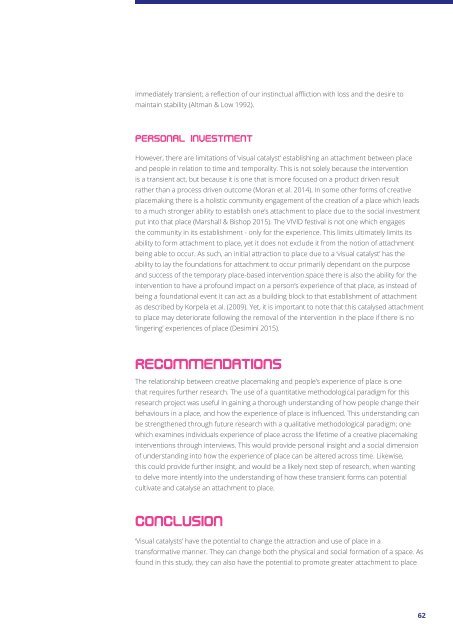Exploring the Role of 'Visual Catalysts' on Influencing People's Attraction and Use of Place
Undergraduate Thesis // Keegan Lovell // Bachelor of Landscape Architecure // UNSW 2016
Undergraduate Thesis // Keegan Lovell // Bachelor of Landscape Architecure // UNSW 2016
You also want an ePaper? Increase the reach of your titles
YUMPU automatically turns print PDFs into web optimized ePapers that Google loves.
immediately transient; a reflecti<strong>on</strong> <str<strong>on</strong>g>of</str<strong>on</strong>g> our instinctual afflicti<strong>on</strong> with loss <strong>and</strong> <str<strong>on</strong>g>the</str<strong>on</strong>g> desire to<br />
maintain stability (Altman & Low 1992).<br />
PERSONAL INVESTMENT<br />
However, <str<strong>on</strong>g>the</str<strong>on</strong>g>re are limitati<strong>on</strong>s <str<strong>on</strong>g>of</str<strong>on</strong>g> ‘visual catalyst’ establishing an attachment between place<br />
<strong>and</strong> people in relati<strong>on</strong> to time <strong>and</strong> temporality. This is not solely because <str<strong>on</strong>g>the</str<strong>on</strong>g> interventi<strong>on</strong><br />
is a transient act, but because it is <strong>on</strong>e that is more focused <strong>on</strong> a product driven result<br />
ra<str<strong>on</strong>g>the</str<strong>on</strong>g>r than a process driven outcome (Moran et al. 2014). In some o<str<strong>on</strong>g>the</str<strong>on</strong>g>r forms <str<strong>on</strong>g>of</str<strong>on</strong>g> creative<br />
placemaking <str<strong>on</strong>g>the</str<strong>on</strong>g>re is a holistic community engagement <str<strong>on</strong>g>of</str<strong>on</strong>g> <str<strong>on</strong>g>the</str<strong>on</strong>g> creati<strong>on</strong> <str<strong>on</strong>g>of</str<strong>on</strong>g> a place which leads<br />
to a much str<strong>on</strong>ger ability to establish <strong>on</strong>e’s attachment to place due to <str<strong>on</strong>g>the</str<strong>on</strong>g> social investment<br />
put into that place (Marshall & Bishop 2015). The VIVID festival is not <strong>on</strong>e which engages<br />
<str<strong>on</strong>g>the</str<strong>on</strong>g> community in its establishment - <strong>on</strong>ly for <str<strong>on</strong>g>the</str<strong>on</strong>g> experience. This limits ultimately limits its<br />
ability to form attachment to place, yet it does not exclude it from <str<strong>on</strong>g>the</str<strong>on</strong>g> noti<strong>on</strong> <str<strong>on</strong>g>of</str<strong>on</strong>g> attachment<br />
being able to occur. As such, an initial attracti<strong>on</strong> to place due to a ‘visual catalyst’ has <str<strong>on</strong>g>the</str<strong>on</strong>g><br />
ability to lay <str<strong>on</strong>g>the</str<strong>on</strong>g> foundati<strong>on</strong>s for attachment to occur primarily dependant <strong>on</strong> <str<strong>on</strong>g>the</str<strong>on</strong>g> purpose<br />
<strong>and</strong> success <str<strong>on</strong>g>of</str<strong>on</strong>g> <str<strong>on</strong>g>the</str<strong>on</strong>g> temporary place-based interventi<strong>on</strong>.space <str<strong>on</strong>g>the</str<strong>on</strong>g>re is also <str<strong>on</strong>g>the</str<strong>on</strong>g> ability for <str<strong>on</strong>g>the</str<strong>on</strong>g><br />
interventi<strong>on</strong> to have a pr<str<strong>on</strong>g>of</str<strong>on</strong>g>ound impact <strong>on</strong> a pers<strong>on</strong>’s experience <str<strong>on</strong>g>of</str<strong>on</strong>g> that place, as instead <str<strong>on</strong>g>of</str<strong>on</strong>g><br />
being a foundati<strong>on</strong>al event it can act as a building block to that establishment <str<strong>on</strong>g>of</str<strong>on</strong>g> attachment<br />
as described by Korpela et al. (2009). Yet, it is important to note that this catalysed attachment<br />
to place may deteriorate following <str<strong>on</strong>g>the</str<strong>on</strong>g> removal <str<strong>on</strong>g>of</str<strong>on</strong>g> <str<strong>on</strong>g>the</str<strong>on</strong>g> interventi<strong>on</strong> in <str<strong>on</strong>g>the</str<strong>on</strong>g> place if <str<strong>on</strong>g>the</str<strong>on</strong>g>re is no<br />
‘lingering’ experiences <str<strong>on</strong>g>of</str<strong>on</strong>g> place (Desimini 2015).<br />
RECOMMENDATIONS<br />
The relati<strong>on</strong>ship between creative placemaking <strong>and</strong> people’s experience <str<strong>on</strong>g>of</str<strong>on</strong>g> place is <strong>on</strong>e<br />
that requires fur<str<strong>on</strong>g>the</str<strong>on</strong>g>r research. The use <str<strong>on</strong>g>of</str<strong>on</strong>g> a quantitative methodological paradigm for this<br />
research project was useful in gaining a thorough underst<strong>and</strong>ing <str<strong>on</strong>g>of</str<strong>on</strong>g> how people change <str<strong>on</strong>g>the</str<strong>on</strong>g>ir<br />
behaviours in a place, <strong>and</strong> how <str<strong>on</strong>g>the</str<strong>on</strong>g> experience <str<strong>on</strong>g>of</str<strong>on</strong>g> place is influenced. This underst<strong>and</strong>ing can<br />
be streng<str<strong>on</strong>g>the</str<strong>on</strong>g>ned through future research with a qualitative methodological paradigm; <strong>on</strong>e<br />
which examines individuals experience <str<strong>on</strong>g>of</str<strong>on</strong>g> place across <str<strong>on</strong>g>the</str<strong>on</strong>g> lifetime <str<strong>on</strong>g>of</str<strong>on</strong>g> a creative placemaking<br />
interventi<strong>on</strong>s through interviews. This would provide pers<strong>on</strong>al insight <strong>and</strong> a social dimensi<strong>on</strong><br />
<str<strong>on</strong>g>of</str<strong>on</strong>g> underst<strong>and</strong>ing into how <str<strong>on</strong>g>the</str<strong>on</strong>g> experience <str<strong>on</strong>g>of</str<strong>on</strong>g> place can be altered across time. Likewise,<br />
this could provide fur<str<strong>on</strong>g>the</str<strong>on</strong>g>r insight, <strong>and</strong> would be a likely next step <str<strong>on</strong>g>of</str<strong>on</strong>g> research, when wanting<br />
to delve more intently into <str<strong>on</strong>g>the</str<strong>on</strong>g> underst<strong>and</strong>ing <str<strong>on</strong>g>of</str<strong>on</strong>g> how <str<strong>on</strong>g>the</str<strong>on</strong>g>se transient forms can potential<br />
cultivate <strong>and</strong> catalyse an attachment to place.<br />
CONCLUSION<br />
‘Visual catalysts’ have <str<strong>on</strong>g>the</str<strong>on</strong>g> potential to change <str<strong>on</strong>g>the</str<strong>on</strong>g> attracti<strong>on</strong> <strong>and</strong> use <str<strong>on</strong>g>of</str<strong>on</strong>g> place in a<br />
transformative manner. They can change both <str<strong>on</strong>g>the</str<strong>on</strong>g> physical <strong>and</strong> social formati<strong>on</strong> <str<strong>on</strong>g>of</str<strong>on</strong>g> a space. As<br />
found in this study, <str<strong>on</strong>g>the</str<strong>on</strong>g>y can also have <str<strong>on</strong>g>the</str<strong>on</strong>g> potential to promote greater attachment to place<br />
62


